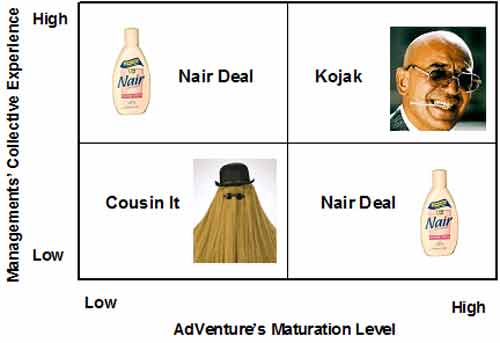 Nair was developed during the 1970s as a hair-removal product for the emerging population of busy, professional women. Despite potential side effects such as itching, burning and scarring, Nair continues to help women effectively remove unwanted hair and leave their skin “smooth and shiny, with no nicks or cuts.”
Nair was developed during the 1970s as a hair-removal product for the emerging population of busy, professional women. Despite potential side effects such as itching, burning and scarring, Nair continues to help women effectively remove unwanted hair and leave their skin “smooth and shiny, with no nicks or cuts.”
Ask any venture investor. They would love to slather their startup investments with Nair. Why? Because every deal has unwanted hair – one or more significant flaws which make the deal imperfect. Savvy entrepreneurs also understand this reality. As a result, they do everything within reason to reduce the hair on their adVenture before they seek investment capital.
Startup hair is often related to two key issues, (i) the experience and maturity level of the Core Team and (ii) the adVenture’s stage of maturation. These two factors can counteract each other. For instance, if a Core Team is relatively inexperienced, but the adVenture is generating revenue, has a cadre of satisfied customers and a reasonable path to sustainability, then the operational risk associated with the Team’s limited experience is significantly mitigated.
Conversely, if the adVenture is in the product development, pre-revenue stage, the operational risk is reduced if the Core Team has a relevant track record of success. These two criteria are obviously not exhaustive of the factors investors consider when evaluating a venture investment. However, when these two risk factors are evaluated in tandem, the results can be enlightening, as depicted in the following four-by-four.

Who Loves Ya?
A Kojak deal is one with virtually no hair. In the above example, it represents a deal in which the management team has applicable experience and the adVenture’s business opportunity has been validated. Much like the fanciful storylines of the 1970s Kojak TV show, such deals are largely fictional.
Kojak deals command hefty valuations, which are advantageous for the operators, but ironically represent a form of hair to potential investors. As such, no matter how perfect a deal may seem, there are usually countervailing factors which will make the deal less attractive to a subset of potential investors. To quote the lollipop-sucking star of Kojak, the fundraising process is a painful way to determine, “Who loves ya baby?”
They’re Creepy and They’re Kooky
At the other extreme, Cousin It deals are covered with hair. Just as you cannot see Cousin It’s face in the 1960s TV show The Addams Family, Cousin It deals are so inundated with hair that it is often impossible to see the opportunity that might lie beneath. In the above example, management may lack relevant experience and the business opportunity is unproven. Such deals are best funded by customer dollars until the opportunity is adequately proven and/or management accrues an acceptable level of experience. Even if you soak these creepy, kooky deals in metaphorical Nair, it will likely only result in unsightly burns and itching, making the deal no less difficult to fund.
Despite the Kojak and Cousin It extremes, most deals that qualify for serious evaluation by institutional investors are Nair deals. These deals comprised both attractive and troubling attributes. No matter how attractive the opportunity, there are always risk factors that detract from a deal’s desirability. Entrepreneurs must proactively identify such concerns and either Nair them away or devise a reasonable story which acknowledges the problematic issues and explains why they will not materially impact the adVenture’s chances of success.
Throw Hubby Under the Bus
After many months of discussions with a promising software company, our venture fund declined to invest in the company, as the Founders were not willing to address the hair on their deal. In this instance, the Founders were married. The wife was the CEO and her husband was heading up sales, product development and customer service. Rather than proactively address the concerns that such a familial relationship raised at their startup, the Founders denied that it was “an issue.” As a result, we decided to not invest in the company.
My favorite counsel to someone who has a poor rapport with his or her boss: “If you have a problem with your boss, then you have a problem.” This same sage advice can be applied to a Nair deal. If your investors have a problem with your deal, then you have a problem. Denying an issue or trying to convince an investor that he or she is “wrong” are generally not viable strategies.
In the case of the software company, Nair could have been applied in the form of hiring other senior, strong-willed executives who could counterbalance the input of the married Founders. Although this would not have eliminated the issue, it would have mitigated potential investors’ concerns that the company might become a myopic dictatorship run by two very closely aligned people. Augmenting the management team with senior talent would also reduce the risk that deterioration in either the Founder’s marriage or the job performance of one of the Founders would fatally impact the organization.
Shining, Gleaming, Steaming, Flaxen, Waxen
 Deal hair, just like the real thing, comes in a variety of colors and styles. Some of the most common types of deal hair include:
Deal hair, just like the real thing, comes in a variety of colors and styles. Some of the most common types of deal hair include:
Junky Capitalization Table – A hodgepodge of small investors that could cause potential headaches for management and/or institutional investors.
- Nair Solution – Repurchase as much stock as is practical and convert any remaining preferred stockholders to common stock status.
Untenable Bridge Terms – Convertible debt terms that are prohibitive to an institutional investment, such as large discounts and/or warrant coverage that dilutes the intuitional investor’s investment.
- Nair Solution – Marginalize the relative dilutive impact of these terms. For instance, a discount of less than twenty percent is usually deemed reasonable. In addition, converting warrant coverage to non-participating status will also enhance your adVenture’s fundability.
Band of Brothers – Friends, family, former roommates and other unqualified people occupy senior management positions.
- Nair Solution – Replace such mis-hires with strong-willed, independent executives who have relevant, successful track records.
IP Confusion – Questionable ownership of key intellectual property, including non-exclusive licenses, potential infringement of a third party’s technology and/or inappropriate use of open-source tools.
- Nair Solution – In most failed adVentures, the only asset of value upon dissolution is the underlying intellectual property. As such, it is paramount that investors can unequivocally evaluate its veracity.
Legal Landmines – No matter how frivolous, lawsuits will seriously chill investors’ interest.
- Nair Solution – As noted in Roping In The Legal Eagles, it is generally advantageous to fight nuisance lawsuits to avoid becoming known as easy mark for unscrupulous lawyers. However, when fundraising, it is more appropriate to expeditiously resolve any litigation (potential or otherwise), rather than expend energy convincing a skeptical investor that your legal issues are without merit.
Geographic Dispersion – Significant physical separation of Core Team.
- Nair Solution – During an adVenture’s early days, virtual teams are often viable. However, as a company accelerates its growth by deploying its institutional funding, the Core Team cannot afford to be handicapped by disparate locales. As such, the Core Team should be prepared to relocate to a central location within a reasonable period after obtaining funding.
Way Outsourcing – Outsourcing core competencies.
- Nair Solution – Identify the areas of your adVenture that are critical to its success and internally develop the necessary levels of core competency. For instance, technology startups should maintain key development resources in-house, rather than relying exclusively on third-party, contract labor. If your business model is predicated on superior online marketing expertise, do not utilize consultants to craft and execute your online marketing initiatives.
Double Agent – Problematic agency issues, such as high salaries, non-entrepreneurial perks (car allowances, exorbitant travel expenditures, etc.), side businesses and/or cross-ownership of related businesses.
- Nair Solution – The addition of disciplined, experienced investors to your adVenture team will require you to run your business with a focus on creating long-term value. As such, eliminate any unconventional forms of compensation or other potential areas of Agency conflict before you are forced to do so by a prospective investor.
Before you seek investment capital, do what you can to make your adVenture smooth and shiny, with no nicks or cuts. Although judicious use of metaphorical Nair on your adVenture will help your fundraising efforts, it is often also necessary to unequivocally acknowledge the remaining deal hair. It should be shampooed, conditioned and styled in the most attractive manner possible. Trying to cover up deal hair with a cap and deny its existence is not a viable strategy. If you remove and groom the hair on your deal, there will be no doubt as to “Who loves ya baby?”
***************************
Special thanks to Jim Andelman, Founder and General Partner of Rincon Venture Partners (www.rinconvp.com) for his hairy suggestions.
—
Copyright © 2008 by J. Meredith Publishing. All rights reserved.




Pingback: Making your venture more fundable by removing potential red flags
Pingback: Quora